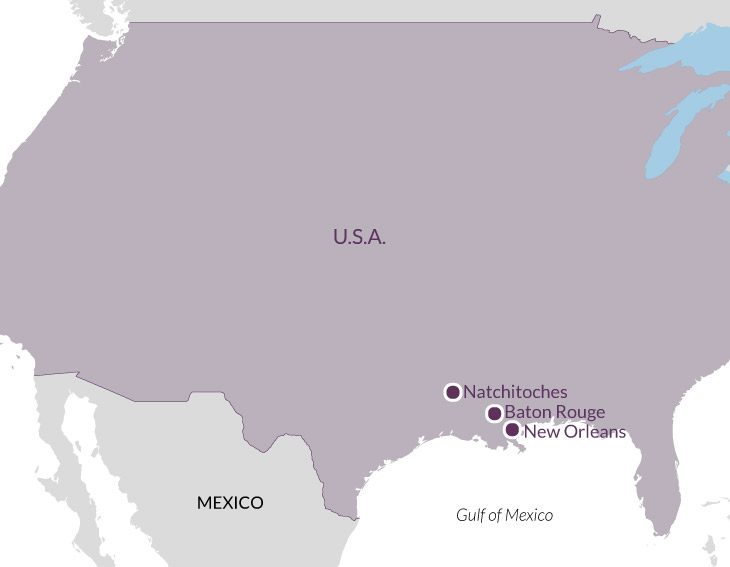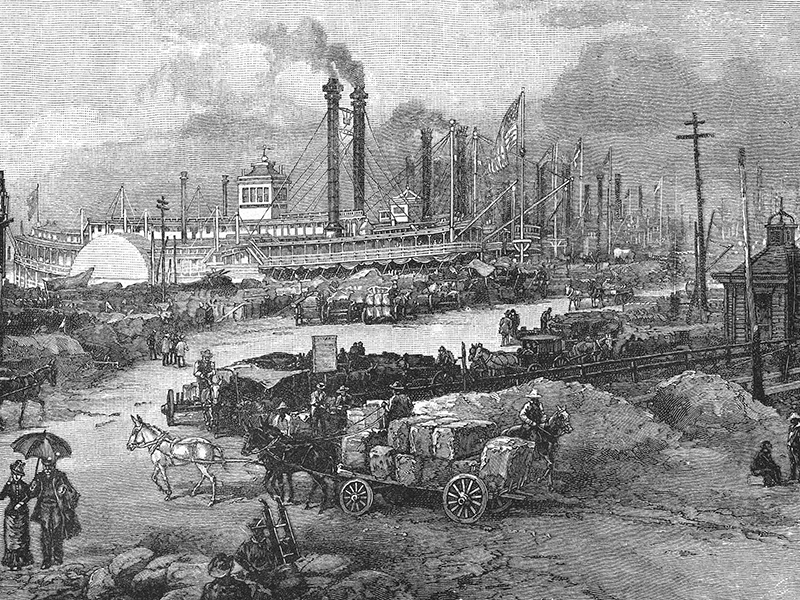Overview
Dominated by New Orleans and the Mississippi River, an exploration of Louisiana reveals a rich history and culture. Named by French settlers after Louis XIV, the state has also been home to Native Americans, Spanish, Germans and Africans, each bringing their own cuisine, traditions and music to the region. Some groups, such as the French-Canadian Cajuns, remained distinct and preserved their customs and language, while others melded into a unique Louisiana culture, which translates into ‘laissez les bons temps rouler,’ a local credo.
New Orleans captures the energy of this vibrant mix, with jazz heard from every street, day and night. Culture drips from everywhere, like Spanish moss on the region’s languid trees. Even the devastation of Hurricane Katrina (2005) has inspired a creative response to re-building, and a new City Park filled with art and sculpture remains a vibrant memorial to survival.
The city owed its riches to the trade that flowed down the Mississippi and through its port. Those enslaved worked the cotton fields in the upper South and the sugar plantations in the Gulf South; they might be bought and sold in New Orleans, the largest slave market operated in North America. Here, wealthy sugar barons built lavish town houses from where they might entertain and conduct business. Slowly, their abodes along the river grew from modest plantation houses to vast mansions, a sharp contrast to the slave cabins scattered far from sight.
In Natchitoches, the first French settlement in the state, members of the Creole Metoyer family rose from slavery to become some of the wealthiest plantation owners in the area. The cotton plantation houses of the Cane River remain almost intact in this northern rural region. A former plantation worker, Clementine Hunter, captured her life on Melrose Plantation in a series of paintings that remains on the site. Surrounded by pecan orchards and with a river running beside its historic main street, Natchitoches retains the southern slow-paced way of life, captured in Robert Harling’s 1987 play, Steel Magnolias.
The unconventional politics of 1930s Louisiana are epitomised in the career of Governor Huey P. Long, whose grandiose constructions in Baton Rouge reflect the future he imagined for Louisiana and himself, before being assassinated in the marble corridors of his Art Deco State Capitol. Long’s story was the basis for Robert Penn Warren’s novel, All the King’s Men, earning America’s most coveted literary prize, the Pulitzer, in 1947.
Day 1
London to New Orleans. Fly at c. 2.00pm (British Airways) from London Heathrow to New Orleans, arriving c. 7.30pm (total flying time c. 10 hours). Transfer to the hotel in the French Quarter. First of three nights in New Orleans.
Day 2
New Orleans. A day on foot in the colourful French Quarter, with its ornate cast-iron balconies, lush courtyards and garden squares. Visit the Historic New Orleans Collection which gives an overview of the city. The 18th century Spanish buildings surrounding Jackson Square include St Louis Cathedral, the oldest Catholic cathedral in the US, and the Cabildo, now the state museum. Overnight New Orleans.
Day 3
New Orleans, Edgard. A working sugar cane plantation, Evergreen’s 37 outbuildings spread across the estate make it one of the most intact plantation complexes along the Mississippi. The Whitney Plantation museum focuses on the lives of Louisiana’s enslaved people. Overnight New Orleans.
Day 4
New Orleans, Nottoway. Botanical Gardens thrive in an area destroyed by Hurricane Katrina and the Sculpture Park displays works by Renoir, Magritte, Hepworth and Moore. The extensive collection of works in the New Orleans Museum of Art concentrates on American and French artists, including Degas. In the afternoon visit Nottoway Plantation, one of the largest houses in the South, designed by Louisiana architect Henry Howard. First of two nights in Baton Rouge.
Day 5
Baton Rouge. An early plantation home (dating from 1791), Magnolia Mound shows French and West Indian influences. In downtown Baton Rouge, the Art Deco State Capitol rises to 450 feet and the 27th-floor observation deck affords views across the city. In contrast, the Old State Capitol is an extravagant, castellated Gothic structure with a stained-glass dome. Overnight in Baton Rouge.
Day 6
Lafayette. A morning boat trip (private charter) through bayous overhung with Spanish moss and home to birds and swamp life from alligators to catfish. Drive north to Oakland Plantation with original outbuildings, including the general store and post office, doctor’s house and slave quarters. First of two nights in Natchitoches.
Day 7
Natchitoches. The American Cemetery contains the graves of the first French settlers and the influential Metoyer family. Visits to some of the historic houses (by special arrangement) and the Church of the Immaculate Conception. In the afternoon visit Creole Melrose Plantation, former residence of the artist Clementine Hunter, to see her murals in situ. Overnight Natchitoches.
Day 8
Vermilionville. In an idyllic setting beside the Bayou Vermilion, the open air museum recreates life in the area from 1765 to 1890 through original and reconstructed buildings. First of two nights in New Orleans.
Day 9
New Orleans. Wide, tree-lined avenues form the gracious Garden District, whose mansions are still home to the rich and famous. Gothic novelist, Anne Rice, lived in a Greek Revival-style house and was inspired by the neighbourhood’s Lafayette Cemetery. Free afternoon. Suggestions include returning to the French Quarter for tours of Hermann-Grima House, with original outbuildings and slave quarters and the 1860s Gallier House Museum. Overnight New Orleans.
Day 10
New Orleans, Garyville. A free morning in New Orleans. In the afternoon drive to Garyville and visit San Francisco Plantation House, a distinctive and opulent plantation house on the Mississipi river. Continue to New Orleans Airport in time for the flight to London, departing at c. 9.30pm.
Day 11
Arrive London Heathrow c. 11.00am.
Price, per person
Two sharing: £5,480 or £4,890 without flights. Single occupancy: £6,140 or £5,550 without flights.
Included
Return flights with British Airways (World Traveller, Boeing 747, MD80 Jet) from London to New Orleans; private coach throughout; hotel accommodation as described below; all breakfasts, 3 lunches and 5 dinners with wine, water and coffee (plus meals on flights); all admission charges; all tips; all state and airport taxes; the services of the lecturer and tour manager.
Visas
British citizens can enter the USA without a visa by applying for a visa waiver online. We will advise on this. If you have travelled to Iran, Iraq, Syria, Sudan, Yemen, Libya or Somalia since March 2011 you are not eligible for the waiver and will need to apply for a visa.
Accommodation
The Monteleone, New Orleans: A family-owned French Quarter institution known for excellent service. Hilton Baton Rouge Capitol Center: a chain hotel in a grand, historic building, with rooftop pool. Historic B&Bs, Natchitoches: we are divided between three or four houses in the centre; all have comfortable ensuite rooms with lots of character. Single rooms throughout are doubles for sole use.
How strenuous?
This tour would not be suitable for anyone with difficulties with everyday walking and stair-climbing. Coaches can rarely park near the houses and the plantation houses visited do not have lifts (nor do all the hotels). Average distance by coach per day: c. 70 miles.
Are you fit enough to join the tour?
Group size
Between 10 and 22 participants.
Travel advice
Before booking, please refer to the FCDO website to ensure you are happy with the travel advice for the destination(s) you are visiting.

